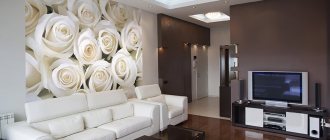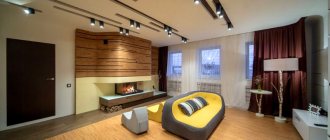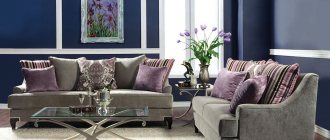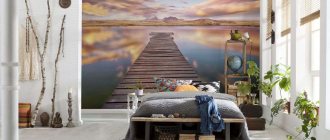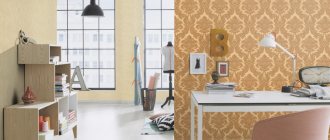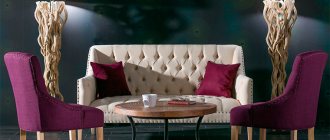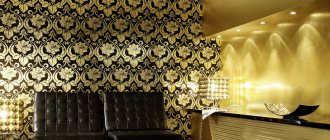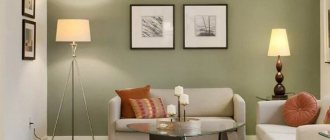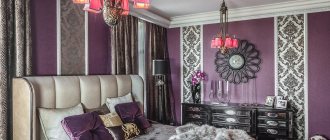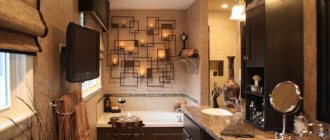Upholstery for sofas and armchairs
If you have no idea how to use burlap in the interior, you probably imagine a rough, scratchy fabric. But it should be noted that burlap comes in 3 types:
- Jute. This material is made of the toughest fibers, but at the same time it is the most wear-resistant.
- Linen. The softest option, consisting of 100% linen.
- Mixed. A mixture of flax and jute 50 to 50. Durable but soft.
Mixed burlap is used for furniture - it lasts a long time and is pleasant to sit on. Some companies offer custom-made burlap sofas, but you can reupholster old furniture yourself.
Thanks to the neutral appearance of the material, you can use any decoration:
- the carriage screed looks amazing in the Provence style living room;
- prints a la prints from coffee bags are suitable for loft interiors;
- Stitching and large buttons would be appropriate for country design.
It is not necessary to select rough, suitable furniture for the decor; try to implement a certain oxymoron - combining incongruous things. Take a baroque chair or stool with carved legs and replace the rich velvet with burlap.
To highlight the original upholstery, surround the upholstered furniture with wood, glass or metal - sisal goes best with them.
The photo shows a version of upholstered furniture made of burlap
Stages and features of gluing walls with fabric wallpaper
Since wallpaper can reveal all the imperfections of the wall covering, before pasting it, you should very well prepare the surface for pasting.
The first thing to do is to clean the wall of old paintings and other materials. Next, the surface is cleaned and plastered. Next, a primer is applied, everything dries and only then can gluing be carried out.
Hanging textile wallpaper is quite a complex and labor-intensive task, so you should entrust it only to professionals; you won’t be able to do this kind of work efficiently on your own. But, if you still have to glue such canvases with your own hands, then you need to know some rules:
- the glue for textile wallpaper is selected the same as for heavy wallpaper;
- apply the composition to the canvas with brushes or a roller;
- The canvas should not be folded, as these places are torn during gluing;
- The material can only be applied end-to-end, but not overlapping.
Tablecloth on the table
What type of burlap to use depends on the style, functionality of the table and your preferences. For the kitchen table, choose thin linen fabric; it is permissible to decorate a coffee table or bedside table with a stiffer material.
A regular tablecloth looks too simple, so decorations will not interfere with it. Sew frills, tassels, ruffles, flowers or ties. Decorate with white patterns or colorful embroidery. The combination with the most delicate lace looks especially harmonious.
How to care for fabric wallpaper
Care directly depends on the type of textile:
1) Velor and felt wallpaper quickly absorbs odor and dust, so they should be periodically vacuumed and wiped with a damp cloth.
2) Jute, linen, silk wallpaper should be vacuumed or wiped with a dry cloth or brush.
Wet cleaning is prohibited.
3) Polyester or polypropylene can be washed and even cleaned using a washing vacuum cleaner.
Chair covers
Most often, chairs are “dressed up” on the occasion of an important event; burlap products are used to decorate celebrations in a rustic, boho, rustic or eco style.
The covers are one-piece, that is, they involve both the back and the seat - they require a soft or medium-hard fabric. And partial, that is, decorating only the back - any fabric, including jute, will do here.
For a home or cottage in a suitable style, the upholstery of chairs can generally be replaced with burlap. This furniture is ideal for a wooden interior.
The photo shows an example of using sisal on chair covers
Textile wallpaper in the interior
A room decorated with textile wallpaper is automatically filled with a special comfort that closely borders on aristocratic luxury. And the variety of color and texture designs of such coatings allows you to select samples for finishing a room in almost any interior style:
Classic directions. Implemented in the design of a living room, bedroom or office, they seem to be specially created for displaying luxurious fabric wallpaper on the walls.
Emphatically elegant silk, jacquard, velor and tapestry fabrics are simply irreplaceable when decorating a room in the Baroque style, with its elegant pomp. Rooms in the solemn imperial Empire style will not be complete without noble patterns of jacquard, silk and velor. Shimmering golden and silvery shades of natural silk will harmoniously emphasize the royal luxury of Versailles, adding a touch of romance to the interior. Exquisite floral and floral motifs fill the room with special charm and subtle, frivolous tenderness in the spirit of Rococo. Strict heraldic patterns, simple vertical patterns or imitation tapestry give a reference to palace grandeur. Such themes are appropriate in solid living rooms, offices and bedchambers in the spirit of the Renaissance, Victorian and Georgian styles.
Textile wallpapers of noble neutral colors are widely used in classical interiors, emphasizing the love of comfort and loyalty to tradition.
Modern directions. They have a penchant for visual simplicity and minimalism. Linen and jute wallpapers are most in demand here: Plain options - elegantly demonstrate naturalness and environmental friendliness, perfectly complementing the interior of a studio apartment, stylish living room or nursery.
Abstraction and geometric patterns add color and evocative brightness, filling the rooms with dynamics. Linen wallpaper with a simple pattern will be a good solution for decorating a room in the Biedermeier style. Warm felt and luxurious velor coverings will perfectly decorate the walls in the cheerful chaos of fusion style. Unobtrusive textured compositions of discreet colors that imitate natural materials are a win-win option for eco-style interiors.
Ethnic styles. Also inextricably linked with textiles. Including on the walls: Jute models will fill the room with tropical motifs. Exquisite ornate patterns of silk fabrics will add luxury to colorful oriental interiors. Laconic and elegant linen coverings will remind you of Japan, and complemented by symbolic drawings, they will perfectly emphasize the Chinese style in home decoration.
Regardless of the chosen direction, do not forget about the possibility of combining materials. Spectacular and memorable interiors are obtained with the right combination of canvases that are the same color but different in texture, or vice versa, different shades but with the same pattern and texture.
Textile wallpaper in the interior of various rooms - photos
***
Textile wallpaper belongs to the category of premium finishing materials. Diverse in color and texture, but always impeccably elegant, they can transform any room, making its interior incredibly refined and harmonious.
Curtains
Burlap curtains in the interior are extremely versatile:
- straight simple long curtains will decorate a Scandinavian or modern interior;
- models with ruffles and tassels are used on windows in classic decor;
- rolled or Roman ones suit the industrial style;
- multilayer figured curtains emphasize Provence and country style.
Combining burlap with other fabrics or decorative elements can produce amazing results. Play on the contrast of colors with bright chintz or combine textures with flowing organza. Ribbons, braid, lace, embroidery, and prints are suitable as accents. It is not necessary to combine the fabric; you can decorate burlap curtains using tucks or drawstrings.
In the photo there are burlap curtains in the living room
Features of using matting wallpaper in the interior
11
The wall decoration under the matting is original and distinctive. You can safely say about such decor: “Modest, but tasteful!” And indeed, the glass wallpaper seems to dissolve into the interior. The discreet texture plays a role in softening the interior lines.
As a finishing material, wallpaper is valuable for its versatility. With different lighting intensities, they will be perceived either as rough and uncouth decor, or as an elite design. Thanks to its unusual properties, the material is used in a wide variety of stylistic solutions. In the photo, matting wallpaper is present in country, minimalist and classic interiors.
Decorative pillows
Burlap pillowcase - ideas for any interior design. However, it is uncomfortable to sleep on such prickly material, so it is used exclusively for decoration.
If you want a pillow arrangement for your sofa or bed, make it yourself. Sew pillowcases and decorate them as you wish. Draw beautiful birds or animals, embroider bright birds, transfer a family photo, attach unusual buttons or ribbons.
Pillows need to be washed more often than other decor, but this should be done exclusively by hand and only in cold water - the fabric has a high percentage of shrinkage.
The photo shows cute handmade pillows
Matting is a lifesaver when decorating the interior
Walls and ceilings in the interior can have different finishes. Wallpaper is often chosen as the main material. Ideally, they should be wear-resistant, durable, and repairable. Glass wallpaper meets the specified requirements.
Effective textured coatings are recommended for finishing the bases. Made from fiberglass, they perform two functions: decorative and technical. Fiberglass wallpaper is known for its reinforcing properties. As for their decorativeness, the choice of texture is a matter of user taste.
Universal matting
Wallpaper for painting, matting, is one of the most popular materials. The demand for them is constantly growing. The reason is the exceptional durability of the coating and its attractiveness. Often, matting is glued to walls to hide minor defects. And glass wallpaper copes with its functions perfectly. They are characterized by a dimly expressed texture, which creates the effect of a monolithic surface without joints, potholes, cracks, etc.
Wallpaper for painting, matting, is small, as well as large, medium, and has a simple linen weave. It is considered one of the most durable. The perception of wallpaper largely depends on the size and depth of the texture elements. Small matting for painting most often serves as a background for interior compositions. It does not distract attention from decorative elements.
The middle matting can be used as an independent design element. It combines effectively with other simple textures. A technique such as combined finishing is especially relevant for rooms in which it is necessary to zone the space. You can buy a medium matting at a good price at Vitrulan Moscow. German quality material will allow you to create a spectacular and practical interior.
Large matting is distinguished by its texture and expressiveness. It, like the two previous models of glass wallpaper, can play the role of a background, for example, for paintings and tapestries or the basis of a wall panel.
How to use a matting?
Matting is the best option for decorating interiors in eco and country styles. It also looks impressive in minimalist compositions. The price of matting for painting, as well as its simple texture, makes the material attractive to consumers.
Glass wallpaper in this category is distinguished by its naturalness and originality. The matting literally disappears into the interior. She looks natural, graceful and modest. The discreet texture softens the interior lines. At the same time, the matting can also be called paradoxical. In certain colors and lighting it can look rough. But this is why the material is usually valued by designers.
The perception of matting in the interior largely depends on the color of the paint applied to the wallpaper. In light colors the material is ideal for small spaces. A dark, richly colored matting will make a large room more comfortable and compact.
Bright wallpaper, medium matting, will take its rightful place on well-lit walls. It is recommended to choose pastel colors for painting glass panels in rooms with a lack of sunlight.
3 reasons to choose a matting
Fiberglass wallpaper with this texture is worthy of the attention of users for the following reasons:
- The price of medium, small, large matting is more than affordable.
- Three texture sizes provide the ability to choose the optimal finish for walls and ceilings.
- The combination of practical and decorative properties of the material makes it convenient to use. Matting will be the optimal solution for finishing both old foundations and walls in a new building.
Sources: https://dekoriko.ru/nastennye-pokrytiya/oboi/rogozhka/ https://obustroeno.com/instrum-i-material/otdel-materialy/oboi/120468-oboi-rogozhka https://steklooboi-msk .ru/posts-2203499 https://indizajn.ru/rozovye-oboi/
Curtain tiebacks
Such a small detail as a curtain tie, if chosen correctly, will become the highlight of the interior. Tie a burlap ribbon into a regular bow and you will already have an interesting shaped decor. But you can also work hard: make beautiful flowers, plant them on a ribbon and attach them to the curtains. The decoration made from seashells looks unusual.
It is better to use burlap tiebacks on contrasting light fabrics - linen, organza, cotton, mesh. If you have curtains made of this fabric, make a tie from the same fabric or take a jute rope.
Pros and cons of textile wallpaper
Is it even worth choosing such an exotic finishing material as textile wallpaper for your home? There are several arguments for and against.
The advantages are probably more obvious: visual appeal, status, originality. It should also be noted that most of them are environmentally friendly. Increased sound insulation is also important.
But the disadvantages are not immediately clear, so don’t rush to the store. Firstly, you need to be prepared for the fact that in almost 100 percent of cases when gluing textile wallpaper, the joints will be noticeable. All due to the heterogeneity of the color of the fibers.
Secondly, decorating a wall with high-quality fabric wallpaper is not an easy task, even for a pro. You will need to look for an experienced and reliable master. This point also includes the high cost of the wallpaper itself.
Thirdly, textile wallpaper does not perform very well in operation. They tend to collect dust, and they can only be cleaned with a dry cloth - naturally, perfect cleanliness cannot be achieved. Well, any stain on the fabric is still noticeable.
You can still look for shortcomings, but it is already clear that you need to choose textile wallpaper only in special cases, and in which cases - read below.
Burlap wallpaper
Wall decor with burlap in the interior is an unpopular solution, but very original. In addition, such a finishing material will cost you about the same as middle-class wallpaper, and will last longer. The only negative is the presence of joints; most often they are hidden behind wooden planks, but they can also be replaced with jute rope.
Gluing fabric is more difficult than paper or non-woven fabric, but the result is worth it. If a plain wall design seems boring to you, you can always paint patterns on top with regular acrylic paint.
What is wallpaper matting?
“Matting is wallpaper that can be painted”
11
Matting is a fabric woven in a special way (like burlap). Matting wallpaper used in the interior is also woven, but from glass fiber. The output is a fabric similar to dense fabric, only with increased rigidity. Fiberglass wallpapers perfectly hide small flaws in the bases, onto which they are glued and are wear-resistant.
11
Matting is wallpaper that can be painted. Of course, you have the right to leave them in their original form, but still, if you want to give the walls a special flavor, then it is better to decorate them additionally. The paint will fill the cells and make the surface shiny or matte, as required by the interior idea.
Wallpaper of this type can have different textures. This parameter is affected by the size of the cells. Depending on the size of the latter, the matting can be:
- Large cell.
- Medium cell.
- Fine mesh.
11
Each option has its own specific application. How each type of matting wallpaper is used in the interior, look at the photo.
There is an opinion that glass wallpaper is harmful and can only be used in the decoration of non-residential premises: restaurants, cafes, offices. This is completely wrong! Only components of exclusively natural origin are used in the production of finishing materials, so the wallpaper is environmentally friendly and approved for decoration of residential buildings and apartments. Studies have shown that under such finishing the walls do not lose their ability to “breathe”. Decorated surfaces do not collect dust, do not become a breeding ground for mold and mildew, and do not emit toxic fumes. That is why in the photo, wallpaper for painting “matting” is not uncommon in the interior of bedrooms and children’s rooms. The walls decorated with them become an excellent backdrop for exquisite furniture and collections of paintings. In a country setting, the decoration goes wonderfully with wicker furniture, both expensive, made from rattan, and more budget-friendly, made from wicker. Elegant wall decor does not draw attention to itself, but at the same time adds a feeling of incredible comfort to the decor of any room.
Flower pots
Burlap, although coarse and dense, is still fabric, so you shouldn’t plant plants in the bag right away. But it’s perfect for framing flowerpots!
You can take the simplest route and put the pot in a bag - this way you can hide an ugly or unsuitable vessel from prying eyes. Plus, the neutral beige color of the material forms a natural unity with the green leaves of the plants.
Other options require imagination and additional time. Burlap is used to decorate any vessels - from an ordinary plastic bottle or tin can, for example, you can make a stylish planter for small flowers. If the result seems boring, decorate the pot with beads, lace, stones, and buttons.
The photo shows gift pots with succulents in rough fabric
Kitchen accessories
Burlap in the kitchen interior is used not only as a tablecloth, it is used to sew:
- napkins;
- potholders;
- covers for cutlery;
- hot coasters;
- aprons;
- practical bags;
- decorations for jars and containers.
Serving napkins can be labeled for each family member or beautiful designs can be drawn on them.
The bags are suitable for storing vegetables, fruits, cereals, coffee and sweets. Such kitchen decor is ideal for a summer house or country house, but in an ordinary apartment you can easily create the illusion of country life.
What are the varieties?
The classification of textile wallpaper is based on the types of top fabric layer.
These can be natural materials (silk, linen, cotton, jute), artificial (polyester, viscose). Natural materials on the front side:
- Silk. One of the traditional types, a paper covering is used as a base, silk and viscose are used on top. Light resistant and easy to clean.
- Linen. On a paper basis, the front layer is made of linen fabric. They have increased noise and heat insulation as well as antibacterial properties.
- Felt. The surface is soft to the touch. They retain heat well, are wear-resistant, and can visually align walls.
- Jute. On a paper basis, they have the most pronounced texture, often imitation of wood and grass coverings. This texture allows you to hide uneven walls.
These coatings are not moisture-resistant, therefore, they cannot be cleaned using a wet method; due to the rapidity of contamination, they are not suitable for corridors, children's rooms and kitchens.
For use in these rooms, you can choose those types where the fabric is impregnated with special compounds to improve their wear resistance. Artificial materials on the front side:
- Velor. Synthetic, less environmentally friendly. A relief layer of PVC is applied to the paper base. Requires special care.
- Polyester or polypropylene. Less environmentally friendly, but the most convenient to use.
Headboard
We have already mentioned that burlap is often chosen for upholstery due to its practicality and texture. The bed is no exception.
The classic version of a figured headboard with a carriage tie, made in jute fabric, looks both simple and impressive.
If you need to have certain skills to make a carriage tie, then anyone can make a stationary headboard from soft squares. Use thin plywood, padding polyester and burlap. Place the layers on top of each other, secure with a furniture stapler and install on the wall.
Shade
Make a pendant, table lamp or sconce the center of your interior! Replace the standard lampshade fabric with textured burlap and its weaves. Well-stretched material perfectly transmits light, and when assembled with a drawstring, it creates an intimate, homely atmosphere.
With diffused light in warm, natural tones, the room will feel cozier and the lamp will look like a designer accessory.
Silk wallpaper
In addition to textile and liquid wallpaper, silk coating can also imitate other types of wall finishing materials.
Such as:
- Non-woven;
- Vinyl;
- Paper.
They can imitate either a smooth silk coating or look like liquid wallpaper and include sparkles.
If you want to create a rich and luxurious interior, then your choice is textile silk wallpaper; if you want to quickly make cosmetic repairs without calling in professionals, then you can purchase liquid wallpaper. If you want a simple, even coating, then you can buy traditional paper or non-woven wallpaper that imitates a silk coating.
Detailed characteristics of the most popular types of modern wallpaper can be found on the page:
Liquid wallpaper is great for uneven walls, as well as arches and ledges. For smooth surfaces, it is quite possible to use paper wallpaper, for the kitchen and bathroom, washable vinyl wallpaper, and for an expensive office or bedroom, it is best to purchase high-quality fabric wallpaper.
Modern materials are made from high-quality materials, serve for a long time, and a wide palette of textures and colors allows you to choose or even order the best option for finishing materials.
Interior decor and accessories
Perhaps burlap in the interior is one of the most versatile and favorite materials for needlework among creative individuals. From it they create:
- vases;
- baskets for storing things;
- paintings;photo frames;
- Stuffed Toys;
- New Year's toys;
- candlesticks;
- interior dolls and much more.
In addition to the wear resistance, simplicity and environmental friendliness we have listed, burlap is highly breathable, easy to care for, and compatible with many materials. The disadvantages include strong shrinkage during washing and low moisture resistance - keep this in mind before you start creating.
Liquid wallpaper silk: customer reviews
All people, without exception, are amazed by the fact that the canvas can be easily repaired. No other wallpaper, except liquid wallpaper, can be restored so quickly and easily. It is also beneficial that liquid wallpaper can be reused. If there is any mixture left after the repair, it is dried and then used for repairs or for the next repair. The instructions contain information on whether it is necessary to add additional adhesive to the mixture. Most often, the glue is already contained in the wallpaper bag.
Before applying liquid wallpaper, you should carefully prime the wall.
What qualities of liquid wallpaper are users satisfied with?:
- Resistant to fading;
- strength;
- Ease of care and restoration;
- Strong adhesion to the wall;
- Long lasting service;
- Beautiful and pleasant texture;
- Possibility to choose any color scheme;
- Compatibility with any style in the interior, from Gothic to classic;
- Relatively inexpensive;
- Predictable material consumption;
- Not demanding on the walls, you can apply liquid wallpaper to an imperfectly flat surface;
- Easy to remove; if you need to replace the wallpaper, just soak it and remove it with a spatula;
- Environmentally friendly, all components are completely natural.
Related article: DIY New Year's toys: 4 ideas for crafts (12 photos)
It is not advisable to use liquid wallpaper in the bathroom: there is too much moisture there and the plaster may simply deteriorate
But every great thing has its limitations.
It is not advisable to use liquid wallpaper:
- If mold grows luxuriantly on the walls in the room;
- If the room is very damp, cold;
- If there is a large difference in humidity, for example, on an open loggia;
- If there is a large temperature difference, for example, in an unheated country house;
- If the walls are destroyed, crumble, or crack, such walls need reinforcing glass wallpaper;
- If rusting structures are installed in the walls, all nails and screws should only be galvanized.
Most modern apartments have a humidity level suitable for liquid wallpaper and are heated. In those apartments where there is a mold problem, before applying wallpaper you need to treat the wall several times with a specialized anti-mold compound. The lush structure of the wallpaper and natural components serve as an excellent breeding ground for mold, so in damp rooms you need to protect the wallpaper in advance.
Anyone who has used liquid wallpaper for renovations knows that there is nothing difficult in applying them.
There is no need to worry about joining wallpaper strips together according to the pattern, you don’t need an assistant, and there are no problems with glue stains. Liquid wallpaper creates a monolithic plane without seams, joints or defects. They do not peel off, do not crack, do not crumble and do not swell over time.
